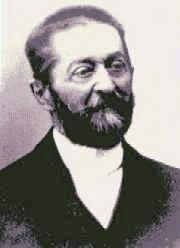Alphonse Beau de Rochas
Alphonse Eugène Beau, later Alphonse Beau de Rochas (born April 9, 1815 in Digne , † March 27, 1893 in Vincennes ) was a French railway engineer and inventor . He is considered to be the inventor of the principle of the four-stroke internal combustion engine and was the first to optimize it. a. the compression of the fuel-air mixture is stimulated.
Life
Beau de Rocha's father, Alexandre Beau, was a tax collector and treasurer at the Caisse d'Epargne . The mother Thérèse Jacques de Rochas came from a noble, influential and wealthy pharmacist family in Digne. When he was nine years old, Beau de Rochas was sent to a Catholic boarding school in Orléans , where he received a strict education. At the age of 16 he returned to Digne and completed an apprenticeship as a geometer .
After his training he worked - often at the same time - on various theoretical projects, for example dealing with the desalination of the Camargue , developed an underwater telegraph together with Philippe Breton or tried a new method for extracting granite and porphyry in Corsica . All these restless efforts were crowned with little success, especially since his sometimes highly inventive approaches were limited to theory and he was unable to muster the possibilities or the patience of practical developments. Another reason could have been his difficult, solitary and quarrelsome character, which made professional success and social recognition difficult for him.
In 1848 he tried his hand at the politics of the new republic , stood as a candidate in the provincial elections, for a while devoted himself to a liberal program he had developed himself, which was strongly influenced by the social ideas of Frédéric Le Play , but withdrew his candidacy for unknown reasons Elections back.
In 1852 he left Digne and went to Paris , where he trained as a railway engineer and became a student of Nicolas Léonard Sadi Carnot , with whom he worked on the technical improvement of steam engines . At the same time, he had the first city guide of Paris printed at his own expense - a brilliant business idea that failed due to insufficient marketing. In the same year he married Elisabeth Lemariée . The marriage remained childless.
In 1861, Beau de Rochas designed the route and routes of the railway line from Grenoble to Nice , which was to be built in 1892 without his financial participation. His design for a tunnel between France and England and for electricity generators that were supposed to supply Paris with electricity also date from 1861 . In 1888 he proposed the artificial irrigation of an oasis in Sudan and designed a trans-African railway route in great detail.
At the end of his life, Beau de Rochas was honored with his invention of the four-stroke engine . He applied for a patent for this invention as early as 1862 . He described engines for locomotives that have a combination of steam and gas engines. The gas in the machine should "ignite spontaneously under high compression", which can be achieved through four phases of machine work:
- Initially by sucking in during a whole piston stroke,
- then a compression in the following bar,
- followed by ignition at the dead point and expansion in the third measure
- and finally the exhaust of the burnt gas from the cylinder in the fourth and final stroke.
With this he had theoretically grasped the principle of the four-stroke engine, although Christian Reithmann had a patent for the four-stroke engine on October 26, 1860. Also Nicolaus August Otto had dealt in 1862 with the development of a four-stroke engine, and receive a patent for it, but what has been revoked because of the priority of the Reithmann's patent later.
literature
- Fernand Letessier: Alphonse Beau de Rochas . Digne 1964
- Gérard Perrin-Gouron: Beau de Rochas . Digne 1978
See also
Web links
- MSN Encarta: Beau de Rochas, Alphonse ( November 1, 2009 memento on WebCite )
- Encyclopædia Britannica: Beau de Rochas, Alphonse
Individual evidence
| personal data | |
|---|---|
| SURNAME | Beau de Rochas, Alphonse |
| ALTERNATIVE NAMES | Beau, Alphonse Eugène |
| BRIEF DESCRIPTION | French railway engineer and inventor |
| DATE OF BIRTH | April 9, 1815 |
| PLACE OF BIRTH | Digne |
| DATE OF DEATH | March 27, 1893 |
| Place of death | Vincennes |
